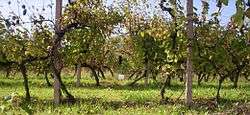Agriculture in Serbia
| Economy of Serbia |
|---|
 |
| Overview |
| Serbia topics |
|
Agriculture in Serbia is still an important section of Serbian economy with an annual potential of EUR 12 billion in exports.[1] The total area of agricultural land exceeds 6.12 million hectares.[2][3] Agricultural production is most prominent in Northern Serbia on the fertile Pannonian Plain, and the southern lowlands adjacent to the Sava, Danube and Great Morava rivers. There has been in a sharp decline in agricultural activity since 1948, when almost three-quarters of the population engaged in farming, to the present one-quarter.[4]
Production
Serbia produces various agricultural products, mostly grains, fruits and vegetables which constitute a significant part of its GDP and exports. Serbia is number two producer of raspberries (84299 metric tons, second to Russia) and plums (146776 metric tons, second to China) in the world, it is also significant producer of maize (6158120 metric tons, ranked 32nd in the world) and wheat (2095400 metric tons, ranked 35th in the world). The production of sugar beet (2299770 metric tons) and sunflower seeds (454282 metric tons) meets domestic demand for sugar and vegetable oil and permits export of some 180,000 tons of sugar to the European Union.[5]
Wine

There are nearly 70,000 hectares of vineyards in Serbia, producing about 425,000 tons of grapes annually, which position Serbia among the first 15 wine producing countries in the world. The majority of production is dedicated to local wineries.
Major varieties include the Belgrade Seedless, Prokupac, Sauvignon, "Italian Riesling", Cabernet, Chardonnay, White and Red Burgundy, Hamburg, Muscat, Afus Ali, Vranac, Tamjanka, Krstac, Smederevka, and Dinka.
Wine production in 2004 was 1,550,000 litres.
Fruit production
Fruit farms cover over 310,000 hectares of arable land in Serbia.
Fruit production volume in tons (2012):[6]
- Apple 178,713
- Grape 263,419
- Peach 53,894
- Pear 39,112
- Plum 391,485
- Raspberry 70,320
- Sour cherry 74,656
Companies
- Fresh&Co, the biggest fruit juice company of Southeast Europe, with the neXt brand of fruit juices
- Foodland, traditional fruits products
- Nektar, fruit company
- Malina Produkt (First Fruit), fruit company
- Mondi Foods (Mondi Serbia), fruit company
See also
References
| Wikimedia Commons has media related to Agriculture in Serbia. |
- ↑ "Serbia's agricultural potential - EUR 12 billion". B92. 15 March 2013. Retrieved 14 June 2013.
- ↑ "Food Industry". SIEPA. Retrieved 14 June 2013.
- ↑ "Agriculture and Enlargement" (PDF). European Commission. May 2011. Retrieved 14 June 2013.
- ↑ "Agriculture and forestry". Encyclopedia Britannica. Retrieved 14 June 2013.
- ↑ "Serbia Overview". Food and Agriculture Organization of the United Nations. Retrieved 14 June 2013.
- ↑ "Food Industry in Serbia" (PDF). SIEPA. Retrieved 14 June 2013.